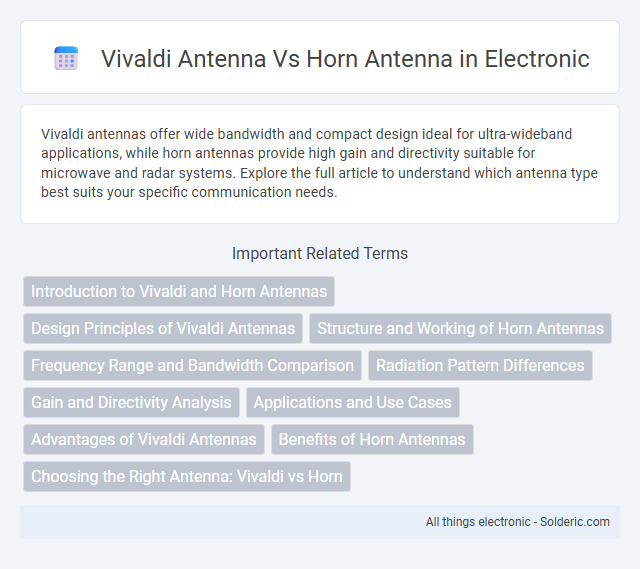Vivaldi antennas offer wide bandwidth and compact design ideal for ultra-wideband applications, while horn antennas provide high gain and directivity suitable for microwave and radar systems. Explore the full article to understand which antenna type best suits your specific communication needs.
Comparison Table
| Feature | Vivaldi Antenna | Horn Antenna |
|---|---|---|
| Type | Planar, Tapered Slot Antenna | Waveguide-Based Flared Antenna |
| Frequency Range | Ultra-wideband (Typically 2 GHz to 20+ GHz) | Wideband (Typically 1 GHz to 40 GHz) |
| Gain | Moderate (5-10 dBi) | High (10-20 dBi) |
| Beamwidth | Wide Beamwidth | Narrow Beamwidth |
| Size & Weight | Compact, Lightweight | Bulky, Heavier |
| Polarization | Linear, Dual-Polarized Options | Generally Linear Polarization |
| Applications | UWB Systems, EMC Testing, Radar, Wireless Communication | Satellite Communication, Radar, Measurement, Testing |
| Manufacturing | Printed Circuit Board (PCB) Process | Metal Fabrication, Machining |
| Cost | Lower Cost, Easier to Integrate | Higher Cost, More Complex Setup |
Introduction to Vivaldi and Horn Antennas
Vivaldi antennas are ultra-wideband planar antennas known for their tapered slot design, offering high directivity and broad frequency coverage from UHF to millimeter waves. Horn antennas feature a flared metal waveguide that efficiently radiates microwave signals, characterized by stable gain and well-defined beam patterns in microwave and millimeter-wave ranges. Understanding these key structural and operational differences helps you select the right antenna for applications requiring wide bandwidth or focused directional transmission.
Design Principles of Vivaldi Antennas
Vivaldi antennas utilize an exponentially tapered slotline design that enables ultra-wideband frequency performance with smooth impedance matching and minimal signal reflection. The antenna's planar structure allows for easy integration into compact systems while maintaining high gain and directional radiation patterns comparable to horn antennas. This design principle ensures efficient broadband operation suitable for applications requiring consistent performance across multiple frequency bands.
Structure and Working of Horn Antennas
Horn antennas feature a flared metal waveguide structure that gradually widens to efficiently radiate or receive microwave signals, providing high directivity and gain. The structure typically includes a rectangular or circular mouth that matches the wave impedance between the waveguide and free space, minimizing signal reflection. Horn antennas operate by guiding electromagnetic waves from a transmission line into free space through the flare, transforming guided waves into radiated waves with controlled beamwidth and reduced sidelobes.
Frequency Range and Bandwidth Comparison
Vivaldi antennas offer ultra-wideband frequency coverage, typically from 1 GHz to over 40 GHz, providing a wider operational bandwidth compared to horn antennas, which generally cover narrower frequency ranges, often from a few GHz up to around 20 GHz. The tapered slot design of the Vivaldi antenna enables smoother impedance matching across a broad spectrum, making it ideal for applications requiring wide frequency agility. Your choice between these antennas depends on the necessary bandwidth and frequency range, with Vivaldi antennas excelling in wideband performance while horn antennas deliver higher gain but limited frequency coverage.
Radiation Pattern Differences
Vivaldi antennas exhibit a wideband directional radiation pattern with a smooth tapering beamwidth, ideal for ultra-wideband applications requiring consistent gain across frequencies. Horn antennas typically present a well-defined, narrow beam pattern with high directivity and low side lobes, making them suitable for point-to-point communication and radar systems. Understanding these radiation pattern differences helps you select the most appropriate antenna for your specific spatial coverage and frequency range needs.
Gain and Directivity Analysis
Vivaldi antennas typically exhibit moderate gain values around 8 to 12 dBi with wide bandwidth performance, making them suitable for ultra-wideband applications, while horn antennas achieve higher gain ranging from 15 to 25 dBi due to their larger aperture and flared structure. The directivity of horn antennas is significantly superior, often exceeding 20 dBi, providing a highly focused beam ideal for point-to-point communication links, compared to the broader radiation pattern of Vivaldi antennas. This disparity in gain and directivity stems from the horn's physical geometry that enhances aperture efficiency, whereas Vivaldi designs optimize impedance matching and wideband functionality with some compromise on beam sharpness.
Applications and Use Cases
Vivaldi antennas excel in ultra-wideband applications such as radar systems, wireless communications, and electromagnetic compatibility testing due to their frequency versatility and compact design. Horn antennas are preferred in satellite communications, radio astronomy, and microwave frequency measurements because of their high gain and directional beam properties. Both antenna types serve critical roles in electromagnetic research, but Vivaldi antennas offer greater adaptability in broadband sensing, while horn antennas dominate in high-power and high-frequency signal transmission scenarios.
Advantages of Vivaldi Antennas
Vivaldi antennas offer ultra-wideband frequency coverage and high gain, making them ideal for broadband communication and radar systems. Their planar, compact design allows easy integration into arrays and modern printed circuit boards, enhancing system miniaturization. Compared to horn antennas, Vivaldi antennas provide superior impedance matching and lower profile, improving efficiency and reducing physical footprint in high-frequency applications.
Benefits of Horn Antennas
Horn antennas offer high gain and excellent directivity, making them ideal for microwave and millimeter-wave applications. Their wide bandwidth and low VSWR ensure minimal signal reflection and efficient power transmission. The robust design and ease of fabrication contribute to their widespread use in radar systems, satellite communication, and radio astronomy.
Choosing the Right Antenna: Vivaldi vs Horn
Vivaldi antennas offer ultra-wideband performance and compact size, making them ideal for applications requiring broad frequency coverage and high directivity in limited spaces. Horn antennas provide high gain and minimal signal distortion, suited for high-frequency measurements and radar systems where precision and power handling are critical. Selecting between Vivaldi and horn antennas depends on bandwidth requirements, physical constraints, and the need for gain versus size efficiency in specific communication or sensing applications.
Vivaldi antenna vs horn antenna Infographic

 solderic.com
solderic.com